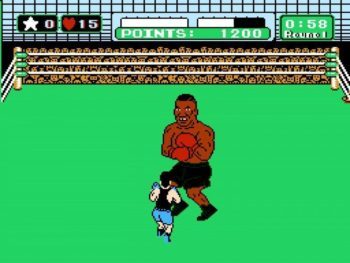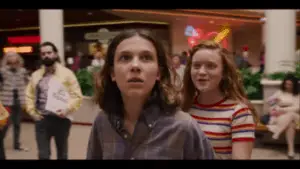
The 80s was a period of many technological advances and a TV character would be created that would embrace the modern technology.
Max Headroom was a fictional artificial intelligence character who was played by Matt Frewer. He was considered the first computer-generated TV host but the effect was created by makeup and prosthetics. He would be used in TV shows and commercials.
You might only have awareness of Max Headroom from Back to the Future II when he’s on the TV in the Cafe ‘80s or you might remember him from the New Coke commercials. But the story of Max Headroom is an interesting one as it’s part performance art, part ingenuity and maybe a bit of absurdity.
Max Headroom made a real splash in the ‘80s trying to capitalize on the advancements in technology and become a true TV personality. You might think of him as just a one-off use for things like this but there’s quite a lot of backstory, a movie and TV shows that developed the character.
There was also the very bizarre “Max Headroom incident” which I’ll get to later.
So he was part cartoon, part video game but had a lot of story and development that went behind him. So if you have wondered who Max Headroom is, you’re about to find out.
The Early Conception Of Max Headroom
Wait, I’m not talking about him being conceived I’m meaning the development of the actual concept. His parents were not a Commodore 64 and a Speak N Spell.
We live in an age now with pretty mindless and morornic entertainment channel “personalities” that are all really a dime a dozen if you ask me. They’re all trying to be the next Ryan Seacrest and they’re all pretty insufferable. Except for Mario Lopez, he gets a pass.
In the ‘80s you had a big explosion of insincere and egotistical TV personalities and this created an idea that would develop into Max Headroom and his personality. He would be created by a few people including George Stone, Annabel Jankel, and Rocky Morton.
They were also sick of the sterile, one dimensional, insincere and arrogant douchebags they were seeing on every channel. The concept was put together and the idea was to base Max partly on Ted Baxter from the Mary Tyler Moore Show.
They brought in actor Matt Frewer as he had a lot of improv ability, wit and was able to imply that sense of self-importance and general douchebaggery.
The “Backstory” On Max Headroom
They covered all their bases and wanted their “computer creation” to have a proper backstory for their TV show. I think they also had the idea that this could have a lot of spin-off opportunity into feature movies or comic books so they wanted to have a mythology to Max Headroom in the same way the Transformers did when being introduced.
The story with Max Headroom is that he comes from a dystopian future which is dominated by television and large corporations. Sort of Bladerunner-ish I’m thinking. The artificial intelligence used in Max Headroom is said to have come from a crusading journalist named Edison Carter.
Carter is a hard-hitting reporter for Network 23 and tends to uncover things at the network that his superiors wish he hadn’t. Eventually, he learns too much and has to flee his work which leads him getting injured by a motorcycle which puts him in a coma.
Max Headroom is the computer reincarnation of Edison Carter and his name comes from the last thing that Carter saw before getting hit in the parking lot: A sign that said “Max Headroom: 2.3 meters”.
Brilliant.
Creating The Look Of Max Headroom
A lot of people always believed that Max Headroom was a computer-generated image but there’s nothing animated or CGI based at all, so they did their job well.
The look of Max Headroom involved a dark shiny suit which was actually made out of a fiberglass mold. He would wear Ray-Ban sunglasses and would actually be put in front of a “computer-generated” background which was the inside of a slowly rotating wire cube. This was totally an analog creation and would have to be controlled manually.
As much as they might have wanted to create a computer-generated image for all this the technology just wasn’t there in the mid-1980s. Most of the backgrounds were actually hand drawn. These hand-drawn animation cells were created by Rod Lord who would also create “computer-generated” images for Hitchhikers Guide To The Galaxy.
The image of Max Headroom would be superimposed over these cell drawn backgrounds and that helped to give everything a true computer-generated look. In future releases, they would use actual computer-generated images that were created by the Commodore Amiga but up until then, everything you saw was straight up analog.
To create more of the look of Max Headroom prosthetics would be used and Latex and foam makeup would be used to create the robotic look of his face. Max Headroom would only be shot from the shoulders up so all the attention would be mainly on his head.
It would take four and a half hours to get all the makeup and prosthetics onto Matt Frewer who said it was not fun and “grueling”. He also compared the entire outfit and makeup to feeling like he was on the inside of a giant tennis ball.
Creating The Voice Of Max Headroom
This was the only bit of technology that would be used. Max Headroom spoke in a very stuttery and glitchy manner. He had a distorted and electronically sampled voice that made a lot of people think he was a genuine robot of some sort.
He had chaotic speech patterns that would have his voice pitching up and down randomly. Sometimes he would get stuck in an electronic stuttering loop, just think back to the Cafe ‘80s.
All these different modulations were achieved using a harmonizer and they would also use one to recreate the effect in life situations.
First Appearances Of Max Headroom
Max Headroom first appeared on TV – in England of all places – in a British made cyberpunk movie called Max Headroom: 20 Minutes Into The Future that was broadcast in 1985. You can check out the whole thing on YouTube if you’re so inclined. It’s pretty nuts.
This TV movie was kind of a hit and after that, he would star in his own show in England. It was called the Max Headroom Show and it was a video music program where he would be the veejay. I grew up in England but have no recollection of this. I’m thinking it was to try and be their own attempt at an MTV style show? But they still had Top Of The Pops so who the hell knows.
This debuted on Channel 4 and was a legit hit doubling the ratings of what was normally in its time slot. It ran for 3 seasons and would include celebrity interviews and a studio audience.
The second and third seasons were actually shown in the U.S by those old rascals at Cinemax. The Max Headroom show finished in England in 1986 but Cinemax would create a fourth season on its own made up of seven episodes. These were never shown on British TV, however.
It’s weird to see that this whole phenomenon started in England like most things tend to do but it was a big hit and won a BAFTA award for graphics in 1986.
They also made a Christmas special…
The Max Headroom Series
This whole thing has jumped around between years and countries. The Max Headroom series was shown in the U.S and would last for two seasons in mid-1987 and late 1987. It was a spinoff of from that original movie and was an actual dramatic TV series.
These were short series and I vaguely remember them. I swear they were on Sunday nights here and it would have been the only exposure I would have had to Max Headroom. I don’t recall much of them but clearly remember this being something unique and different.
I’m not really sure who the target market was for Max Headroom? Teenagers or adults? Was it for kids or did they even know who they wanted to target?
Even though it was short lived they also put out two more episodes in 1988. Either way, Max Headroom was on the radar.
New Coke
OK, if you don’t know about the crazy story of New Coke you need to check out my blog all about it.
Here’s a quick recap: Coca-Cola was losing traction in the market and Pepsi was breathing down their necks. They decided to relaunch Coke but with a whole new sweeter flavor. Some say this was a way to start using high fructose corn syrup, some say it was to compete with the flavor of diet drinks but they ended up changing it.
It was testing pretty well but when they rolled it out people HATED it. They might have liked it if it was a separate product but it had totally replaced normal Coke. Coca-Cola wasn’t banking on the nostalgia factor and taking away a beloved product.
Basically, within less than a year they got rid of New Coke and rebranded regular Coke as Coca-Cola Classic. Some say this was their intention all along to create a renewed interest in an old product but who really knows.
Anyway, one of the big commercial campaigns would involve Max Headroom. With New Coke, they were trying to create a new hipper image so the young whippersnappers would be all over it. They wanted New Coke to follow this new wave attitude and music that was popular in 1985 and take an MTV type approach to their advertising.
What else was popular along with MTV and veejays? One Max Headroom and he would promote the new wave attitude for New Coke with the slogan “Ca-ca-ca-catch the wave!”
I think they were effective ads and a lot better than the Bill Cosby ones that he complained about possibly derailing his career due to the monumental failure of New Coke. Ya, that’s what did it…
The Max Headroom Incident
OK, this one is bizarre af, so be warned.
On November 22, 1987 two different TV stations in Chicago had their signal interrupted by an unknown person who was wearing a Max Headroom mask,
The first hijacking took place 25 seconds into a sports highlights broadcast on WGN-TV channel 9 in Chicago. Two hours later another station hijacking happened at 11 pm on a PBS affiliate that was airing an episode of Dr. Who. This intrusion lasted for 90 seconds.
Through the different hijackings, the person in the Max Headroom mask and sunglasses went on some bizarre rants. He talked all about the involvement with New Coke, he talked about an old TV series from the ‘60s called Clutch Cargo and ripped on WGN sports news anchor Chuck Swirsky.
There was a homemade Max Headroom background that was being rocked around as the hacker spoke and he talked in a distorted voice. It was a piece of corrugated metal that they used to try and recreate a Max Headroom background.
The second hacking ended with the persons pants pulled down, bare ass, while he got spanked with a flyswatter by someone in a French maid’s outfit. I won’t share some of the other details but you can’t make this stuff up.
WTTW had their transmitter on the top of the Sears Tower and were trying to cut the signal but couldn’t because they didn’t have any engineers on duty. They basically had to watch helplessly until the video hijacking ended.
It was never discovered who did the hacking but there are theories it was a disgruntled former employee of WGN.
Wrapping It Up
It turns out I was only barely aware of Max Headroom in the ‘80s. I didn’t realize how deep all of this went especially with the extensive backstory through the movie and TV shows.
They were playing around with a movie called Max Headroom For President but it ended up being canceled.
Max Headroom has lived on and remains a significant, albeit weird, part of the ‘80s. Seeing him in Back To The Future II was amazing as well as being featured in Ready Player One.
I honestly think this whole concept could work well if it was re-introduced in movie form, or some other format, with what they could do with modern CGI and technology into it.
But I’m still waiting on a Flight of the Navigator reboot…




Comments
Comments are closed.